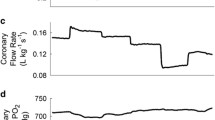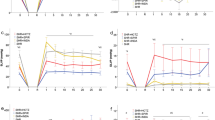Abstract
It was the aim of this study to evaluate the effects of hyperthyroidism on heart function and cardiac energy metabolism of spontaneously hypertensive (SHR) rats. Hyperthyroidism was induced by daily injections of T3 (0.2 mg/kg s.c.) for 14 days. The hearts were then isolated and perfused in the Langendorff mode. ATP, phosphocreatine (PCr), and inorganic phosphate (Pi) were measured continuously by means of31P-nuclear magnetic resonance (NMR) spectroscopy. Work load was altered by varying stepwise the Ca++ concentration in the perfusion fluid from 0.5 to 1.0, 1.5, and 2.0 mM, respectively. At every elevation of the Ca++ concentration, the increase in left ventricular developed pressure (LVDP) was higher in the hyperthyroid SHR than in the untreated SHR hearts. The ATP and PCr concentrations were lower in the hyperthyroid SHR compared to the untreated SHR hearts throughout the perfusion period. PCr decreased at every Ca++ elevation in both the untreated and hyperthyroid SHR hearts. The PCr/ATP ratio was not altered at any Ca++ concentration neither in the untreated SHR nor in the hyperthyroid SHR hearts. The Ca++-induced stepwise elevation in LVDP was higher at any given PCr/Pi ratio in the hyperthyroid SHR than in the untreated SHR hearts. Thus, the Ca++-inducible contractile reserve was greater in the hyperthyroid SHR heart.
Similar content being viewed by others
References
Folkow B, Hallbäck M, Lundgren Y, Weiss L: Background of increased flow resistance and vascular reactivity in spontaneously hypertensive rats. Acta Physiol Scand 80: 93–106, 1970
Spech MM, Ferrario CM, Tarazi RC: Cardiac pumping ability following reversal of hypertrophy and hypertension in spontaneously hypertensive rats. Hypertension 2: 75–82, 1980
Frohlich ED: Is the spontaneously hypertensive rat a model for human hypertension? J Hypertension 4 (suppl 3): S15-S19, 1986
Trippodo NC, Frohlich ED: Similarities of genetic (spontaneous) hypertension. Man and rat. Circ Res 48: 309–319, 1981
Levy D, Garrison RG, Savage DD, Kannel WB, Castelli WP: Prognostic implications of echocardiographically determined left ventricular mass in the Framingham heart study. N Engl J Med 322: 1561–1566, 1990
Heckmann M, Zimmer H-G: Effects of triiodothyronine in spontanously hypertensive rats. Studies on cardiac metabolism, function, and heart weight. Basic Res Cardiol 87: 333–343, 1992
Lortet S, Zimmer H-G, Rossi A: Inotropic response of the rat heart during development and regression of triodothyronine-inducted hypertrophy. J Cardiovasc Pharmacol 14: 707–712, 1989
Aussedat J, Ray A, Lortet S, Reutenauer H, Grably S, Rossi A: Phosphorylated compounds and function in isolated hearts: a31P-NMR study. Am J Physiol 260: H110-H117, 1991
Chevalier B, Mouas C, Mansier P, Aumont MC, Swynghedauw B: Screening of inotropic drugs on isolated rat and guinea pig hearts. Methods Pharmacol 17: 313–326, 1987
Zierhut W, Zimmer H-G: Triiodothyronine-induced hemodynamic and metabolic changes: effects of α- and β-adrenergic blockade. Basic Res Cardiol 84: 359–370, 1989
Zimmer H-G, Peffer H: Metabolic aspects of the development of experimental cardiac hypertrophy. Basic Res Cardiol 81 (Suppl 1): 127–137, 1986
Giesen J, Kammermeier H: Relationship of phosphorylation potential and oxygen consumption in isolated perfused rat hearts. J Mol Cell Cardiol 12: 891–907, 1980
Aussedat J: Effect of uridine supply on glycogen resynthesis after ischaemia in the isolated perfused rat heart. Cardiovasc Res 17: 145–151, 1983
Rosner B: Fundamentals of biostatistics. PWS-Kent Publishing Company, Boston 1990
Kobayashi K, Neely JR: Effects of increased cardiac work on pyruvate dehydrogenase activity in hearts from diabetic animals. J Mol Cell Cardiol 15: 347–357, 1983
Clarke K, Willis RJ: Energy metabolism and contractile function in rat heart during graded, isovolumic perfusion using31P nuclear magnetic resonance spectroscopy. J Mol Cell Cardiol 19: 1153–1160, 1987
From AHL, Petein MA, Michurski SP, Zimmer SD, Ugurbil K:31P-NMR studies of respiratory regulation in the intact myocardium. FEBS Lett 206: 257–261, 1986
Matthews PM, Williams SR, Seymour AM, Schwartz A, Dube G, Gadian DG, Radda GK: A31P-NMR study of some metabolic and functional effects of the inotropic agents epinephrine and ouabain, and the ionophore RO2-2985 (X537A) on the isolated, perfused rat heart. Biochim Biophys Acta 720: 163–171, 1982
Zweier JL, Jacobus WE: Substrate-induced alterations of high energy phosphate metabolism and contractile function in the perfused heart. J Biol Chem 262: 8015–8921, 1987
Rupp H, Jacob R: Response of blood pressure and cardiac myosin polymorphism to swimming training in the spontaneously hypertensive rat. Can J Physiol Pharmacol 60: 1098–1103, 1982
Jacob R, Ebrecht G, Kissling G, Rupp H, Takeda N: Functional consequences of cardiac myosin isoenzyme redistribution. In: H Rupp (ed). The regulation of heart function. Basic concepts and clinical applications. Thieme, Stuttgart New York 1986, pp 305–326
Limas C, Limas CJ: Influence of thyroid status on intracellular distribution of cardiac adrenoceptors. Circ Res 61: 824–828, 1987
Tsai JS, Chen A: Effect of L-triiodothyronine on (−)3H-dihydroalprenolol binding and cyclic AMP response to (−) adrenaline in cultured heart cells. Nature 275: 138–140, 1978
Williams LT, Lefkowitz RJ, Watanabe AM, Hathaway DR, Besch HR: Thyroid hormone regulation of β-adrenergic receptor number. J Biol Chem 252: 2787–2789, 1977
Hoh JFY, McGrath PA, Hale PT: Electrophoretic analysis of multiple forms of rat cardiac myosin: Effects of hypophysectomy and thyroxine replacement. J Mol Cell Cardiol 10: 1053–1076, 1977
Hoh JFY, Egerton LJ: Action of triiodothyronine on the synthesis of rat ventricular myosin isoenzymes. FEBS Lett 101: 143–148, 1979
Seymour A-ML, Eldar H, Radda GK: Hyperthyroidism results in increased glycolytic capacity in the rat heart: A31P-NMR study. Biochim Biophys Acta 1055: 107–116, 1990
Author information
Authors and Affiliations
Rights and permissions
About this article
Cite this article
Heckmann, M., Lortet, S., Aussedat, J. et al. Function and energy metabolism of isolated hearts obtained from hyperthyroid spontaneously hypertensive rats (SHR). Mol Cell Biochem 119, 43–50 (1993). https://doi.org/10.1007/BF00926852
Issue Date:
DOI: https://doi.org/10.1007/BF00926852




